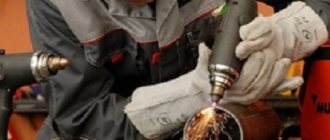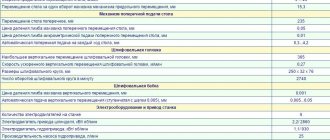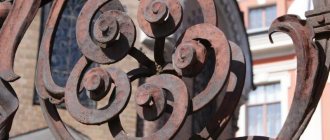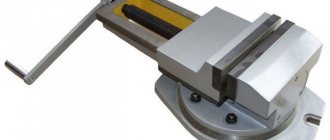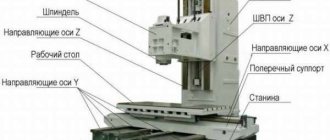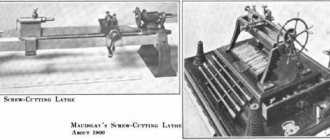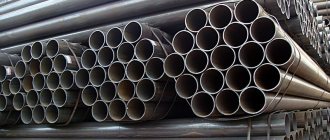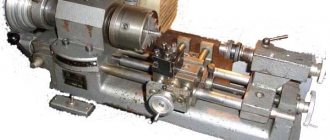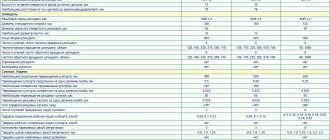Home / Equipment for furniture makers
Reading time: 2 minutes
A
A
An edge banding machine (or edge maker) is one of the most complex devices actively used in furniture production. Its task is to veneer the edge of a furniture piece with a straight or curved shape.
After processing with an edger, the elements of future furniture acquire an aesthetic, neat appearance and receive additional protection from mechanical damage and delamination.
Not a single modern furniture production can do without this device. Even private production and repair of furniture requires an edger. Unfinished ends are already considered low production.
- Principle of operation of the mechanism Basic classification of edgers
- Main characteristics
Purpose:
The machines cover straight and curved edges of furniture panels and blanks with natural strip or synthetic roll material. Edgebanding machines are divided into simple positional ones with manual feeding of workpieces, single-sided edgebanding machines and double-sided edgebanding lines. The equipment options for each type of machine are also different - the configuration of edge banding equipment depends on the complexity of the furniture elements, the volume of its production, the customer’s wishes for the quality of the veneer and other nuances.
Positional edge banding machines.
Designed for lining straight and curved edges of furniture panels and blanks with natural strip or synthetic roll material.
Principle of operation:
- Fig.1
Edge gluing on positional edge banding machines is done using granular hot melt adhesive. The glue is poured into a bath, where it melts due to heating elements at a certain temperature set by an electronic device. The hot melt adhesive from the bath is fed onto a glue spreading roller with a dosing device. The dosing device is used to regulate the consumption of applied glue. Typically, hot melt adhesive in these machines is applied to the edge, but there can also be a combined application of glue to the edge and the workpiece.
So, the edge material is driven by a drive mechanism using a foot pedal at a certain feed speed (usually adjusted and adjusted to the workpiece). Next, hot glue is applied to the edge and by moving the workpiece manually along the table, the machine operator grabs the edge with the applied glue and moves the workpiece at the feed speed of the edge. rolling it by pressing the workpiece against stationary or driven rollers. By releasing the foot pedal, the edging material is cut automatically by the guillotine and its feeding stops, thereby making the machine ready for applying an edge to the next workpiece.
Now all that remains is to remove the overhangs of the edge material from the workpieces using hand or electric tools or special equipment.
Photos of machines:
- Fig.2
- Fig.3
The operation of a positional edge banding machine can be viewed at the link or
Positional edgebanding machines are produced in Russia, the CIS and many countries in Europe and Asia with various characteristics.
Hot melt adhesive for positional edge banding machines
We recommend using hot melt adhesive for low feed speeds and low melting temperatures. The adhesive produced by Kleiberit brand 788.3, a medium-filled hot melt adhesive for edges made of veneer, PVC, ABS and impregnated paper for manual machines, is well suited for these purposes. Technical parameters of the glue can be found here.
Features of materials
A variety of materials can be used for cladding slabs:
- PVC and other types of plastic.
- Paper. It usually has several layers or is reinforced with other material.
- Melamine.
- Veneer.
The thickness of the edge material should be 0.4-3 millimeters, and the width should be from 2 to 6 centimeters. Due to the fact that the machine creates high pressure, the lining is securely fixed to the edge.
Most often, an edgebanding machine is oriented towards the use of special hot-melt adhesive. When heated, it begins to melt, and when cooled, it hardens. This technology allows you to reliably fasten the edge and material, but the specialist needs to monitor the temperature of the adhesive composition. If you do not do this, the system will lose stability - in other words, the edge will peel off.
To reduce labor costs and rationally solve the issue of optimizing the work process, it is best to buy an automatic edge banding machine. Such a unit will eliminate the human factor, increase production volumes, and also reduce costs. The main advantage of automatic equipment is that it is suitable for both small-scale and large-scale furniture production. Such units are compact in size, so they will not take up much space in small workshops.
The most popular among private craftsmen, businessmen and large organizations are the WoodTec Compact series edge banding machines, as well as the EdgeMatic PRO industrial equipment. They are in demand in all countries of the former CIS because they have high power, which ensures their stable and efficient operation throughout their entire service life.
Single Side Automatic Edge Banding Machines
Purpose: Automatic edge banding machine, pass-through type, designed for lining the edges of the straight sides of panels in automatic mode with various edge materials.
Principle of operation:
- Fig.4
- Fig.5
- Fig.6
Let's consider the principle of operation on a machine with the maximum configuration of units and devices included in the machine. Machines are available with and without CNC. CNC machines are controlled by an electronic device capable of changing machine settings automatically; on non-CNC machines, equipment adjustment is done manually. During processing, workpieces are moved by means of a drive conveyor with an adjustable feed speed or without adjustment.
The first unit in the machines (Fig. 4 on the left) is the unit for preliminary milling of the end of the workpiece. Allows you to eliminate defects on workpieces that arise as a result of cutting (chips, steps from a scoring saw), as well as defects associated with the low quality of chipboard, MDF board materials (thickening at the ends). Next: IR - lamp for preheating the workpiece Allows preheating of the end of the workpiece before the glue-applying unit to improve adhesion and uniform distribution of the glue-melt. Next: Edge material feed magazine Includes a driven feed roller and a special holder for feeding strip material. Next: Glue application unit This unit is used to apply and adjust the amount of glue. The glue temperature is regulated by an electronic control unit, which ensures that the desired temperature is maintained and prevents overheating of the glue.
The following units installed on the machine are used to process the removal of edge material overhangs. The first unit (Fig. 14 on the left) is the overhang trimming unit. Finish trimming of edge overhangs is carried out automatically using two saws. Next: Overhang milling unit. The milling unit is equipped with two R2 radius cutters and floating tracers that allow you to monitor the thickness of the workpiece, which ensures excellent quality of the machined surface. Next: Unit for automatic rounding of the end corners of the glued edge material Allows you to automatically round the end corners of the edge material without stopping the workpiece. Next: The scraping unit carries out finishing processing of material (pvc/abs) with a thickness of 1 to 3 mm and completely eliminates such a defect as a “kinematic wave” that occurs when milling overhangs of edge material at high feed speeds.
The following units serve to impart a high-quality appearance to the resulting furniture piece. Industrial hair dryers (Fig. 15 on the left). Designed to restore the natural color of the edge material after processing at the scraping unit. Next: Polishing unit. Designed to polish the processed part of the edge, remove excess hot melt adhesive, and give it a natural color and shine.
Photos of machines:
- Fig.7
- Fig.8
The operation of an automatic edge banding machine can be viewed at the link or.
Positional edgebanding machines are produced in Russia, the CIS and many countries in Europe and Asia with various characteristics.
Hot melt adhesive for automatic edge banding machines
The choice of hot melt adhesive is made depending on the equipment used and the tasks facing production. For medium-speed machines, the most suitable is the hot melt adhesive produced by Kleiberit 788.7, a medium-filled hot melt adhesive for edges made of veneer, PVC, ABS and impregnated paper for feed speeds up to 15 m/min, its technical characteristics can be viewed here. For high feed speeds, you can use hot melt adhesive 744.4, a medium-fill hot melt adhesive for veneer, PVC, ABS and impregnated paper edges for feed speeds from 20 to 40 m/min, its technical characteristics can be found here. There are machines manufactured by Holz-her that do not use granular hot melt adhesive, but cartridge adhesive. For these machines, Kleiberit has glue brand 782/.0, its technical characteristics can be found here.
What to look for when choosing an edger
The choice of equipment by the consumer is determined by the goals and influence of the following factors:
- Productivity – the number of linear meters of processed ends per work shift.
- Weight and power.
- The versatility of critical components that perform several functions at once can affect the quality of the product. The result is better if each node does its job separately.
- Equipped with a screw compressor with refrigerated air drying and filters.
- Availability of a router for removing edge strip overlaps.
- Optimal balance of price and quality.
There is a wide range of edgebanding technology available on the market. Popular models:
Brandt machine
Under the Brandt brand, the German company produces a whole range of models of edging machines - pass-through machines designed for gluing edging parts to the straight ends of furniture. The glue is supplied to the end through a special roller. Rotating cylinders then press the tape tightly to the edge.
Additional devices can be installed on brand equipment to expand processing capabilities.
Felder
supplies finishing equipment of several categories:
- The universal series represents machines: ForKa 300$, NeW G 320, 330, 400. The units are small in size. Rolled tape with a thickness of 0.3 mm to 3 mm is used. Laminated chipboards (LDSP) with an end width of 10–45 mm are processed.
- The professional series consists of a number of models: NEW G 500, NEW G 660, NEW G 670, NEW G 680. These are multifunctional machines that perform operations such as jointing, rounding corners, scraping and polishing furniture blanks.
- Premium machines are professional equipment of high quality. The glue line is made in such a way that it is difficult to see. Some of this series are represented by the following models: Perfect 608 x motion plus, Perfect 710 x motion plus, New perfect 812.
- Mobile unit ForKa 200 – manual edge banding machine, small tool. This edger works both in a stationary position and in manual mode. The tool is used mainly for restoration and repair work.
Griggio
Since 1946, the Italian company Griggio has been producing woodworking equipment for various purposes. The leading position in the assortment is occupied by automatic and manual edge banding units of the GB brand. The machines, both in a stationary position and in mobile use, are easy to operate. The automatic device covers the 45 mm wide ends of furniture blanks with tape up to 3 mm thick, and is equipped with a heating regulator and a variator for the feed speed of the part.
Edge maker "Vegoma"
Vegoma multifunctional equipment is produced taking into account the latest achievements in this field. In addition to straight ends, the machine perfectly processes curved surfaces. The machine is equipped with a special glue bath. The tape is fed at a speed of 2 m/min to 6 m/min. Using control via a microprocessor, the degree of heating of the glue is regulated (from 120 to 200 °C). The device uses edge tape with a thickness of 0.3 to 3 mm and a width of 10 to 45 mm.
Additional accessories in the form of tables SE 2001 and SE 2002 fix the installation of PM 3000 in a stationary position. This allows you to process workpieces of a large area.
Equipment MFBJ 350
The mfbj 350 machine is a large stationary equipment, placed on a powerful base, designed for lining straight and curved ends of furniture pieces made of chipboard. For gluing, tape material made of melamine, ABS and PVC with a thickness of 0.3–3 mm and a width of 15–50 mm is used.
The device is equipped with:
- automatic edge feed system from a roll cassette;
- pneumatic tape pruner;
- two adhesive rollers;
- heavy cast iron frame;
- thermostat;
- Teflon-coated glue bath.
Machine KZM-2
The kzm 2 edging machine has the following options:
- An automated edge feed is used, equipped with an indicator height and thickness regulator.
- Pneumatic shears for cutting off protruding edges.
- Milling edge overhangs on both sides.
- Bath with electronic temperature control for heating glue.
- Box with a roll of facing tape with a diameter of 600 mm.
- Saw for trimming the beginning and end of the edge.
Casadei ALA 20
Equipment of the Italian company Casadei ALA 20 has been manufactured since 2008. The desktop has a surface measuring 1950x300 mm. Uses edge thickness from 0.4 mm to 2 mm. The unit processes the ends of chipboards with a thickness of 10–45 mm.
The minimum dimensions of the workpiece to be coated are 180x65 mm. The device feeds the tape at a speed of 5 m/min. The operating degree of heating of the edge is 200 degrees.
KDT-360
The kdt 360 model is a mass-produced product. Heavy equipment is designed for 24/7 operation. The cutters can be tilted at any angle. The device provides finishing milling trimming and high quality scraping. The thickness of the cladding is 0.4–3 mm. The tape feeding speed is within the range of 12–20 m/min. The minimum dimensions of the workpiece are 140x80 mm.
KM-40
The manual edger weighs 11 kg. A convenient tool in all respects. Edge feed speed 2–5 m/min. Works with edging tape heights from 10 to 40 mm.
Scm Olympic
Basically, the products of the Italian company are used for edging the ends of small-sized workpieces. The machines have a number of disadvantages: they are difficult to set up, there is no rear hinged cover, the volume of the glue bath is small, and parts wear out quickly.
Cehisa brand equipment
An automatic one-sided unit produced by a Spanish company is in great demand at furniture factories.
The machine is designed for gluing straight ends. Simple control of the unit allows you to obtain high-quality cladding of furniture parts.
Sietro
Chinese-made machine equipment under the Sietro brand causes considerable complaints from consumers about the quality of the products. The units are often difficult to configure. The only attractive side of edgers is their low price.
Estimated cost of popular edging models:
| № | Model make | Cost, thousand rubles |
| 1 | "Vegoma" | 79 – 85 |
| 2 | Casadei ALA 20 | 300 |
| 3 | KDT 360 | 1 000 |
| 4 | MFBJ | 145 – 150 |
Double-sided edge banding lines
Purpose: allows you to veneer two parallel, opposite edges of a rectangular panel blank in one pass at once, called. Features of double-sided machines: When particle board began to replace wood slabs and other panel parts in furniture production, it turned out that it looked quite unsightly when cut. In addition, formaldehyde is released through its unlined edges, gradually poisoning the entire volume of the room. Therefore, lining the edges of the panel parts from chipboard has become mandatory on all four sides. At the same time, the productivity of a double-sided machine is exactly two times greater than that of a single-sided machine. A double-sided edge banding machine (Fig. 9, 10) is actually two single-sided edgebanders facing each other. They are placed on a single bed so that one of them can move along the guides of this bed to adjust to the width of the workpiece being processed. The units for gluing the edge material and processing the edges are similar to those used in double-sided ones, practically the same as in single-sided ones. Their composition is also selected depending on the type of adhesives and edge material.
Photos of machines:
- Fig.9
- Fig.10
An example of an integrated full-cycle automatic line with two machines:
- Fig.11
1. Automatic loader 2. 1st double-sided machine 3. Turning station 4.2nd double-sided machine 5. Turning station 6. Unloader
Removing excess material
For cladding, a strip or tape with a width exceeding the height of the edge by 2-5 millimeters is glued to the edge of the workpiece, which guarantees its complete closure. Therefore, after gluing, overhangs appear (material that protrudes on both sides of the edge). To remove it, a milling module is used.
The trimming module (the simplest option is a circular saw that moves vertically and has an individual low-power drive) cuts the remnants of the tape, with an allowance adhering to the edge.
Recommendations for choosing hot melt adhesive.
If you have purchased an edge banding machine or an automatic line and you have a question about selecting a hot melt adhesive, contact our specialists and they will always help you choose a hot melt adhesive for your needs. In this case, you need to inform the parameters of the equipment, indicate the list of materials for use on this equipment and the desired result after processing. Our specialists will take part in commissioning work on the commissioning of new or used equipment and will certainly achieve positive results.
